
In recent years, research on image generation based on Generative Adversarial Network (GAN) has made significant progress. In addition to being able to generate high-resolution, realistic pictures, many innovative applications have also emerged, such as personalized picture editing, picture animation, etc. However, how to use GAN for video generation is still a challenging problem.
In addition to modeling single-frame images, video generation also requires learning complex temporal relationships. Recently, researchers from the Chinese University of Hong Kong, Shanghai Artificial Intelligence Laboratory, Ant Technology Research Institute and the University of California, Los Angeles proposed a new video generation method (Towards Smooth Video Composition). In the article, they conducted detailed modeling and improvements on the timing relationships of different spans (short-term range, moderate range, long range), and achieved significant improvements in multiple data sets compared with previous work. This work provides a simple and effective new benchmark for GAN-based video generation.
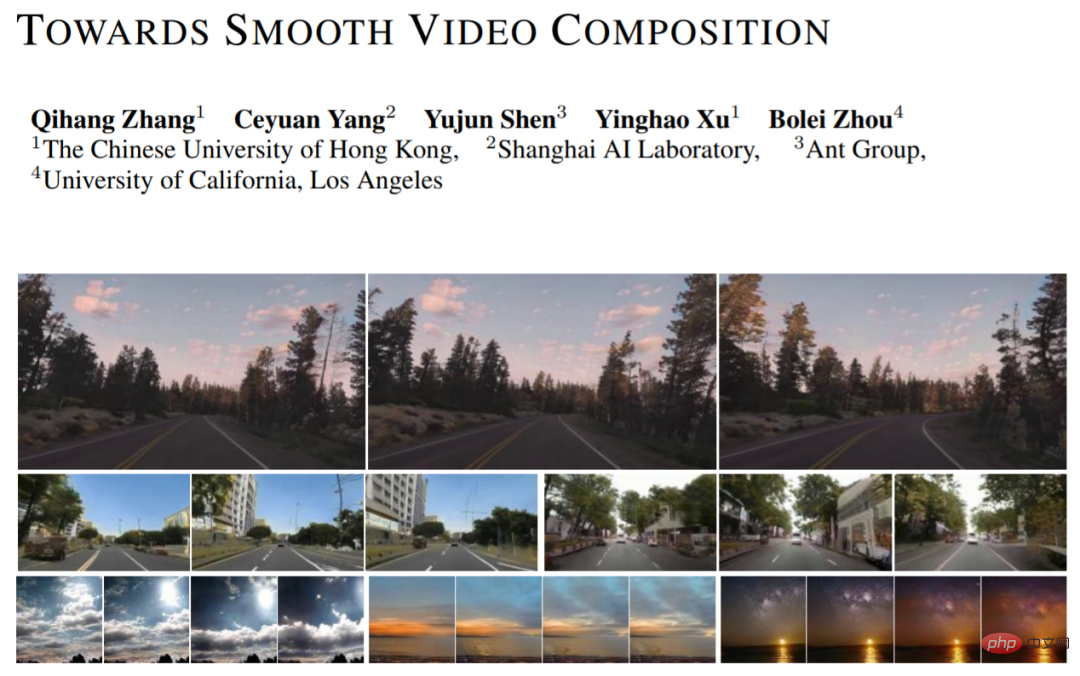
The image generation network based on GAN can be expressed as: I=G(Z), where Z is a random variable, G is the generation network, and I is the generated image. We can simply extend this framework to the category of video generation: I_i=G(z_i), i=[1,...,N], where we sample N random variables z_i at one time, and each random variable z_i generates a corresponding A frame of picture I_i. The generated video can be obtained by stacking the generated images in the time dimension.
MoCoGAN, StyleGAN-V and other works have proposed a decoupled expression on this basis: I_i=G(u, v_i), i=[1,..., N], where u represents the random variable that controls the content, and v_i represents the random variable that controls the action. This representation holds that all frames share the same content and have unique motion. Through this decoupled expression, we can better generate action videos with consistent content styles and changeable realism. The new work adopts the design of StyleGAN-V and uses it as a baseline.
The new work focuses on the timing relationships of different spans (short range, moderate range, long range), and conducts detailed modeling and improvement respectively:
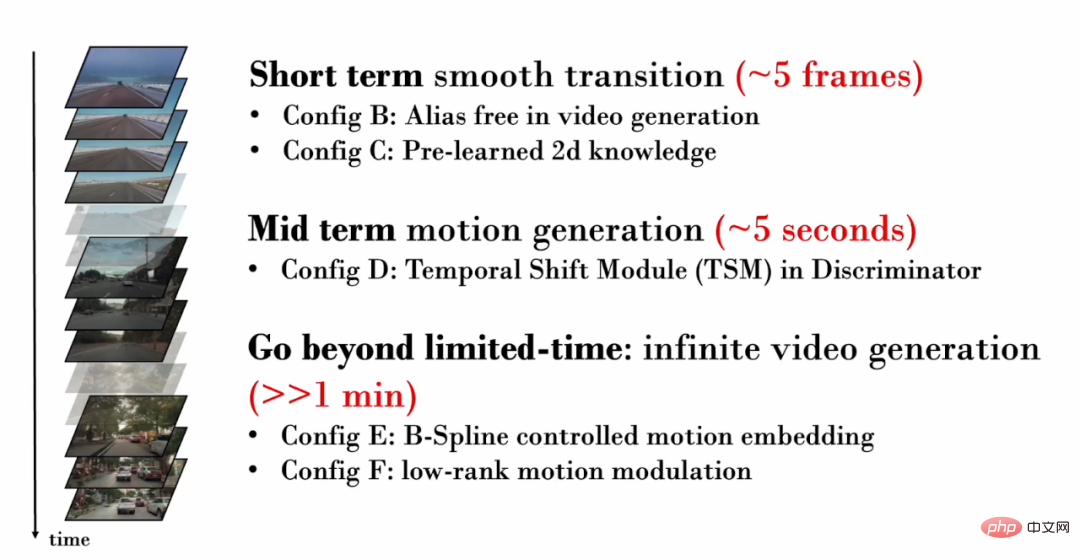
1. Short-term (~5 frames) timing relationships
#Let us first consider a video with only a few frames . These short video frames often contain very similar content, showing only very subtle movements. Therefore, it is crucial to realistically generate subtle movements between frames. However, serious texture sticking occurs in the videos generated by StyleGAN-V.
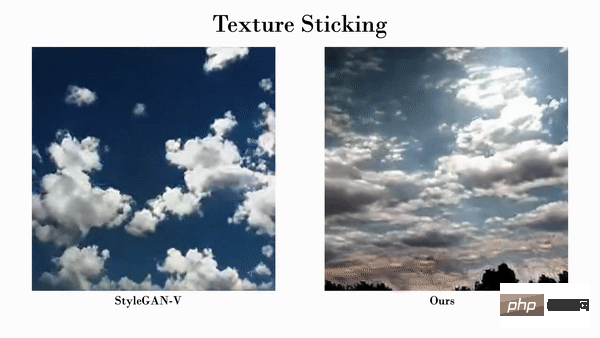
Texture adhesion refers to the dependence of part of the generated content on specific coordinates. This causes the phenomenon of "sticking" to a fixed area. In the field of image generation, StyleGAN3 alleviates the problem of texture adhesion through detailed signal processing, expanded padding range and other operations. This work verifies that the same technique is still effective for video generation.
In the visualization below, we track pixels at the same location in each frame of the video. It is easy to find that in the StyleGAN-V video, some content has been "sticky" at fixed coordinates for a long time and has not moved over time, thus producing a "brush phenomenon" in the visualization. In the videos generated by the new work, all pixels exhibit natural movement.
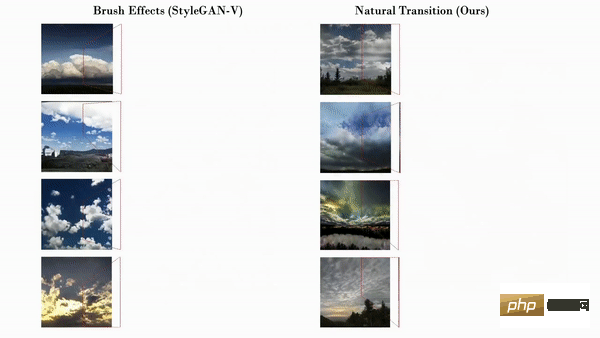
However, researchers found that referencing the backbone of StyleGAN3 will reduce the quality of image generation. To alleviate this problem, they introduced image-level pre-training. In the pre-training stage, the network only needs to consider the generation quality of a certain frame in the video, and does not need to learn the modeling of the temporal range, making it easier to learn knowledge about image distribution.
2. Medium length (~5 seconds) timing relationship
As the generated video has more of frames, it will be able to show more specific actions. Therefore, it is important to ensure that the generated video has realistic motion. For example, if we want to generate a first-person driving video, we should generate a gradually receding ground and street scene, and the approaching car should also follow a natural driving trajectory.
In adversarial training, in order to ensure that the generative network receives sufficient training supervision, the discriminative network is crucial. Therefore, in video generation, in order to ensure that the generative network can generate realistic actions, the discriminative network needs to model the temporal relationships in multiple frames and capture the generated unrealistic motion. However, in previous work, the discriminant network only used a simple concatenation operation (concatenation operation) to perform temporal modeling: y = cat (y_i), where y_i represents the single-frame feature and y represents the feature after time domain fusion.
For the discriminant network, the new work proposes an explicit timing modeling, that is, introducing the Temporal Shift Module (TSM) at each layer of the discriminant network. . TSM comes from the field of action recognition and realizes temporal information exchange through simple shift operations:

Experiments show that after the introduction of TSM, three FVD16, FVD128 on the data set have been reduced to a great extent.

##3. Unlimited video generation
While previously introduced improvements focused on short and moderate length video generation, the new work further explores how to generate high-quality videos of any length (including infinite length). Previous work (StyleGAN-V) can generate infinitely long videos, but the video contains very obvious periodic jitter:
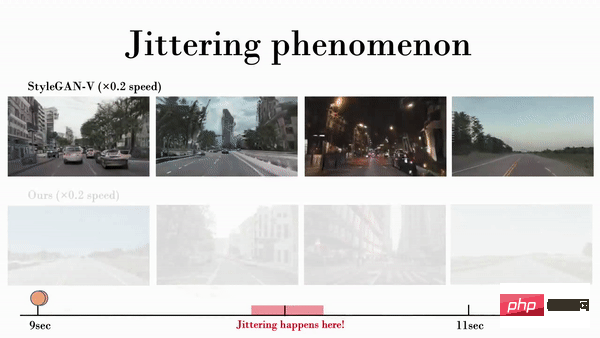

As shown in the figure, in the video generated by StyleGAN-V, as the vehicle advances, the zebra crossing originally retreated normally, but then suddenly changed to move forward. This work found that discontinuity in motion features (motion embedding) caused this jitter phenomenon.
Previous work used linear interpolation to calculate action features. However, linear interpolation will lead to first-order discontinuity, as shown in the following figure (the left is the interpolation diagram, and the right is the T-SNE feature) Visualization):
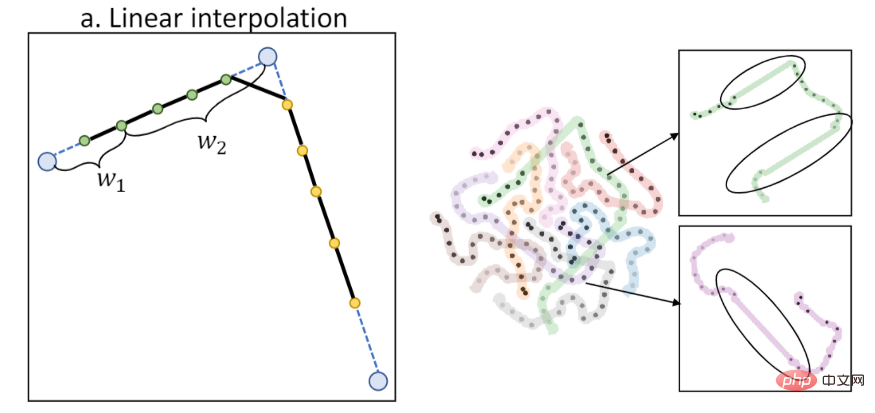
This work proposes the motion characteristics of B-spline control (B-Spline based motion embedding). Interpolation through B-spline can obtain smoother action features with respect to time, as shown in the figure (the left is the interpolation diagram, the right is the T-SNE feature visualization):
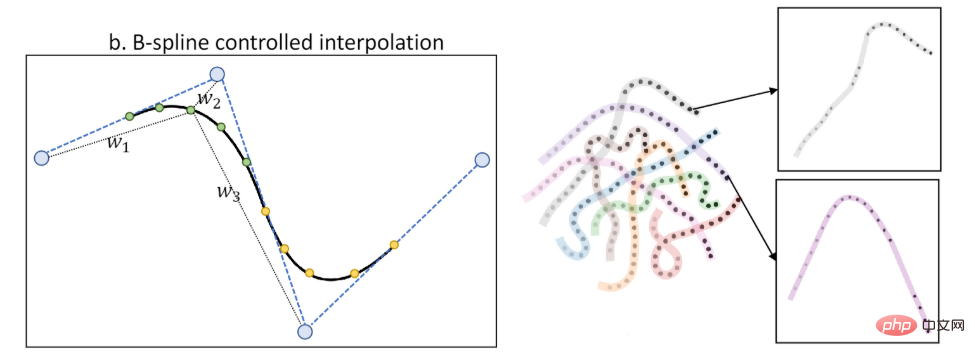
By introducing the action characteristics of B-spline control, the new work alleviates the jitter phenomenon:
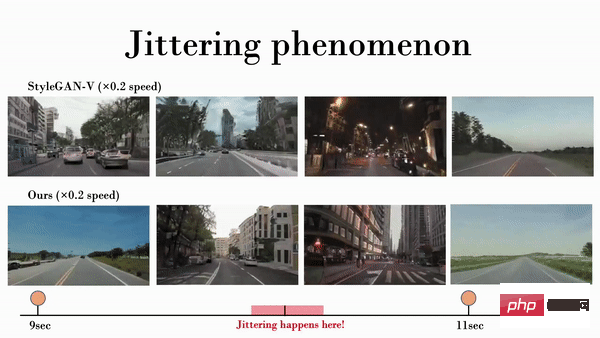
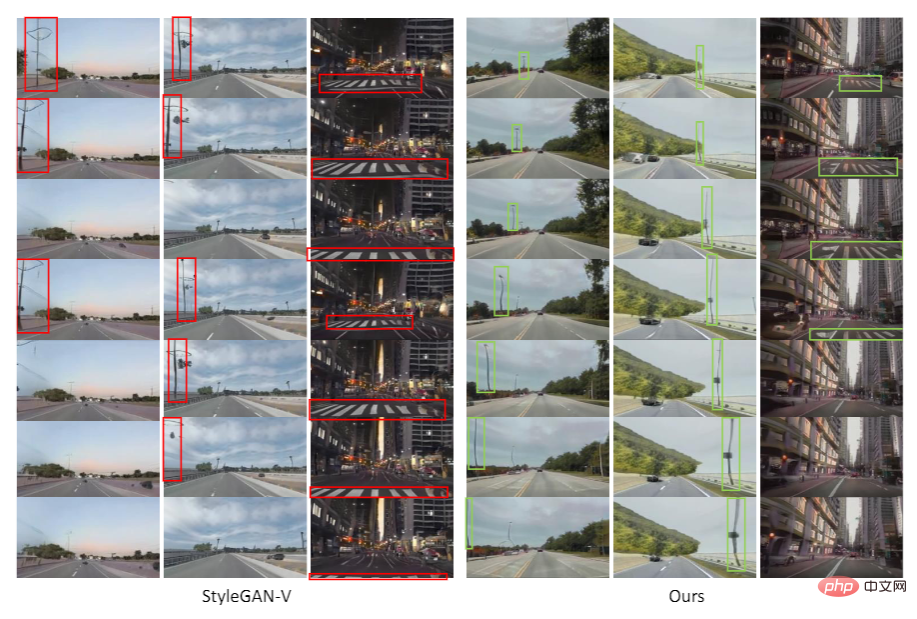
##As shown in the figure, in the video generated by StyleGAN-V, the street lights and the ground will suddenly change the direction of movement. In the videos generated by the new work, the direction of movement is consistent and natural.
At the same time, the new work also proposes a low rank constraint on action features to further alleviate the occurrence of periodic repetitive content.
ExperimentsThe work has been fully experimented on three data sets (YouTube Driving, Timelapse, Taichi-HD) and fully compared with previous work. The results show that the new work has achieved sufficient improvements in picture quality (FID) and video quality (FVD).
SkyTimelapse Experimental results:
 ##
##
Taichi-HD Experiment Result:

## Summary
Summary
The above is the detailed content of Smooth video is generated based on GAN, and the effect is very impressive: no texture adhesion, jitter reduction. For more information, please follow other related articles on the PHP Chinese website!




